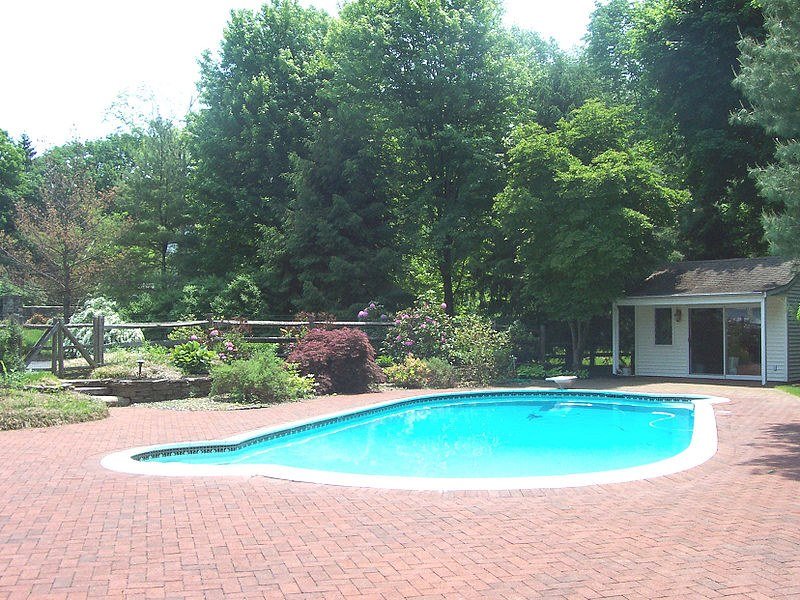Table of Contents Show
The overall cost of building a pool in your backyard will depend on several factors, such as the size and design of the pool, the materials used, and the location of your home.

On average, the cost of an inground pool can range from $25,000 to $100,000, with some high-end pools costing significantly more. Above-ground pools tend to be cheaper with a range of $2,000-$20,000.
It’s highly recommended to get a few quotes from local pool contractors to get a better idea of the cost for your specific project.
What Pool Material Lasts the Longest?
The material that will last the longest for an inground pool is concrete. Concrete pools are extremely durable and can last for many decades with proper maintenance.
Other types of inground pools like fiberglass, vinyl liner pools and prefabricated pools have a shorter lifespan, typically around 15-20 years.
What Material Is Best for a Pool?
Vinyl
Pros
- Cost: Vinyl pools are typically the most affordable option, with costs ranging from $20,000 to $40,000.
- Fast Installation: Vinyl pools can be installed in as little as a week.
Cons:
- Shorter lifespan: Vinyl pools have a shorter lifespan compared to concrete and fiberglass pools, typically around 15-20 years.
- Limited designs: Vinyl pools come in a limited number of pre-made designs, so customization is limited.
- Require liner replacements: Vinyl pools require liner replacements every 8-15 years.
Fiberglass
Pros
- Cost: Fiberglass pools are typically less expensive than concrete pools, with costs ranging from $25,000 to $50,000.
- Fast installation: Fiberglass pools can be installed in as little as a week.
- Low maintenance: Fiberglass pools are easy to maintain and are resistant to algae and bacteria.
Cons:
- Limited designs: Fiberglass pools also come in a limited number of pre-made designs, so customization is limited, but there are many options to choose from.
- Not suitable for colder climates: Fiberglass pools are not suitable for colder climates as the material can crack in freezing temperatures.
- Substantial maintenance: porous plaster reacts to chlorine and can harbor algae, which requires more chemicals and more scrubbing.
Read Also:
Concrete
Pros
- Customization: They can be made in a variety of shapes, sizes, and depths
- Flexible design flourishes: Vanishing edges, tanning ledges, etc.
- Durable and crack-resistant: Concrete pools are less likely to crack or leak due to the strength of the material.
Cons:
- Most expensive: Initial installation ranges from $50,000 to $100,000 or more as well as resurfacing every decade is costly.
- Long install time: Concrete pools take 2-4 months to install.
- Substantial maintenance: porous plaster reacts to chlorine and can harbor algae, which requires more chemicals and more scrubbing.
What Materials Are Good for Outside the Pool?
Your pool is more than the vinyl, fiberglass, or concrete that makes up the liner. It’s also important to give thought to the material that will be surrounding your pool, whether it’s on a deck attached to the house or its own area of your backyard.
Wood
Wood decks are a popular option for pool decks, but they require regular maintenance to keep them in good condition. They provide a natural look and can be stained to match the surrounding landscape.
Stone
Natural stone is a visually pleasing, durable option for a pool deck that can withstand the elements as well as heavy foot traffic. It’s easy to maintain, only requiring occasional cleaning.
Some types of natural stone can be slippery when wet, so be sure to look for slip-resistant stone when shopping around. In the unlikely event that a stone does get damaged, it can be difficult to find a matching replacement.
Brick
Brick is a durable material that can withstand heavy foot traffic and the elements. It’s slip resistant, aesthetically pleasing, and requires minimal maintenance.
However, it can be on the expensive side, is susceptible to cracks over an extended period of time, and if you live in a hot environment, it can absorb the heat and become too hot to walk on.
Vines & Climbers
Climbers are plants that are known to grow vertically (“climb”) and cling to surfaces like walls and fences.
Adding some vines or climbers to your pool area is a great way to add some greenery and privacy. You’ll feel more secluded and shielded from the outside world like your pool area is a natural oasis.
The beautiful, natural aesthetic is appreciated by many, but you should be cautious. These plants can quickly grow out of control, attract bees and insects, and take over your pool area.
What’s the Best Option for You?
There are many factors to consider when choosing a material and design for your pool. It’s important to keep in mind that the pool area is exposed to the elements, so the materials you choose should be able to withstand your region’s weather and regular usage of pool chemicals.
It’s always recommended to consult with local pool contractors and obtain multiple quotes to get the best option for you, according to your budget and needs.









